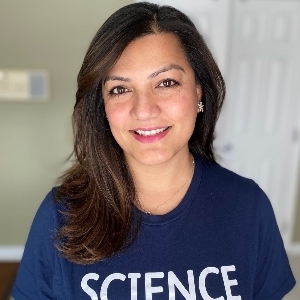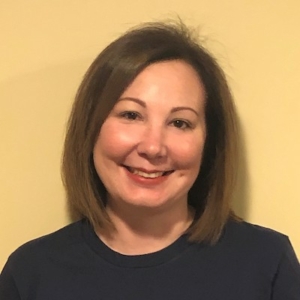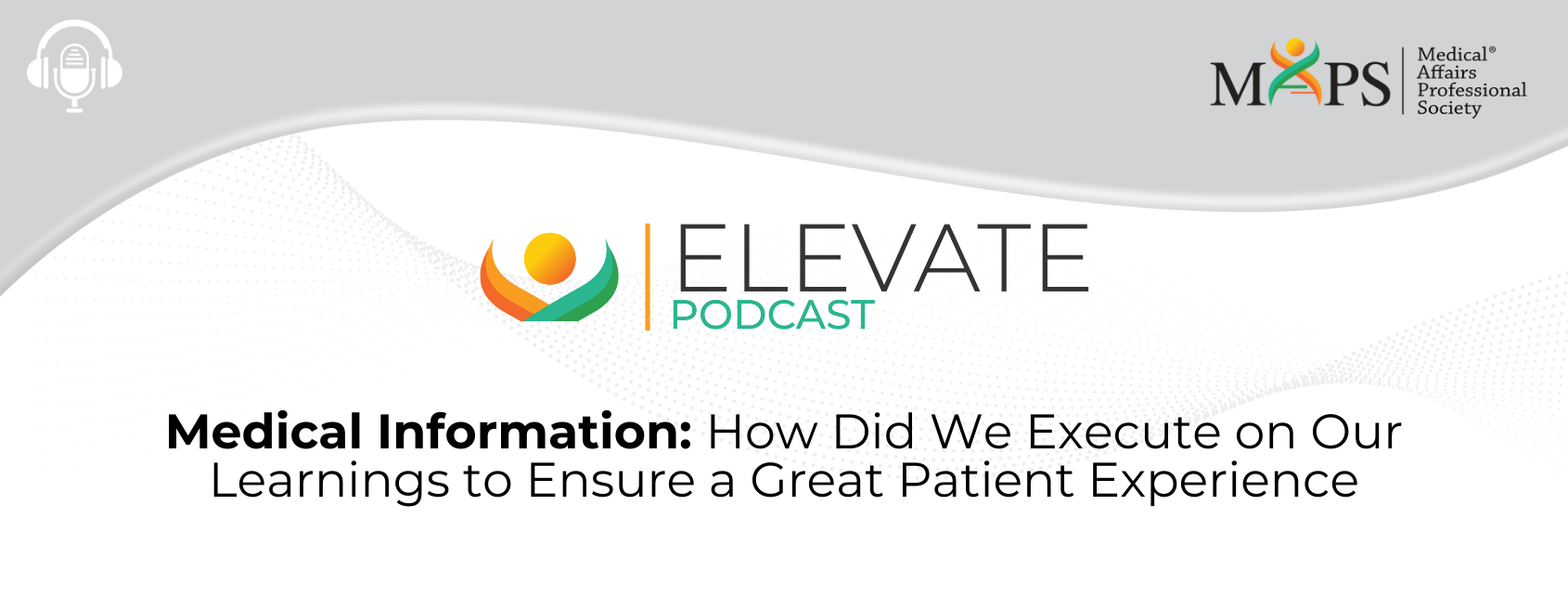Medical Information: How Did We Execute on Our Learnings to Ensure a Great Patient Experience
Objectives
At the end of this series of podcasts, the participant should be able to:
- Discuss the functions and activities of key internal partners
- Identify potential areas for compliant collaboration by MSLs with key internal partners

INTERVIEWER: Sraddha Wadhwa

INTERVIEWEE: Michelle Quinlan, PharmD

INTERVIEWEE: Prachi Parmar
Following is an automated transcription provided by otter.ai. Please excuse inaccuracies.
Sraddha Wadhwa
Welcome to the Medical Affairs Professional Society Medical Information three–part Podcast Series around medical information a patient centric approach and meeting the needs of our patients. In the first two podcasts, we learned about understanding the core goals and activities that support patient centricity within medical information and discuss how medical information colleagues can support patient centric initiatives from Michelle Quinlan and Prachi Parmar. In this third podcast, we will discuss what we implemented from our learnings on how to meet the needs of our patients to ensure a great experience. I am Sraddha Wadhwa, I’ll be the moderator for this podcast. I currently serve as a focus area director in Pfizer Medical Information.
The views expressed in this recording are those of the individuals and do not necessarily reflect on the opinions of MAPS, or the companies which would which with which they are affiliated. This presentation is for informational purposes only and is not intended as legal or regulatory advice. We encourage you to engage in conversations about patient centricity with other MAPS members via MAPS connect on the MAPS website, or mobile app. Simply login with the email address and password associated with your MAPS account and access the MAPS global community. Then click on the discuss tab and scroll down to patient centricity to post a question or review previous postings.
The podcast objectives for podcast three are: What insights we glean from our learnings in the patient space? How did we meet the needs of our patients to ensure a great experience? And, finally provide some examples of Pfizer medical information patient strategy activities.
I’d like to thank today’s panelists for sharing their subject matter expertise with the MAPS membership. Joining me today for our concluding podcast are my friends and colleagues: Michelle Quinlan, Associate Director Pfizer Medical Information and Prachi Parmar, Associate Director Pfizer Medical Information. Michelle, Prachi, would you like to introduce yourselves? Let’s start with Michelle.
Michelle Quinlan
Thanks, Sraddha. I’m Michelle Quinlan. I’m an Associate Director of Medical Information at Pfizer, and I’m currently working to support the internal medicine and rare disease portfolio of products. I’m happy to be here today. Thanks, Michelle. Prachi.
Prachi Parmar
Yeah, thanks, Sraddha and Michelle, my name is Prachi Parmar, and just some background about me, I have spent a large part of my career here in Medical Information at Pfizer, supporting a variety of therapy areas and products. And prior to that, I’ve worked in the long term care setting. Currently at Pfizer, I support a large portfolio of products within the hospital business unit. I’m happy to be here as well.
Sraddha Wadhwa
Thank you both. So, as you know, from the previous two podcasts, Michelle, Prachi, and I have been working together for a while in Medical Information and have done a lot of great work in the patient space, and are here to share the conclusion of our patient engagement journey today. So guys, we talked about the genesis of the patient engagement pillar and the incredible patient insights forum in depth. And now we want to share how we pulled it all together and implemented our findings. But before we even begin with those examples, something we didn’t even touch upon, which I thought was an integral and actually a very fun part of our patient journey was learning and developing Personas. Personas were something completely new to me, and I’m not sure if everyone listening is aware of Personas. So can one of you kick it off about explaining a little more around this topic?
Prachi Parmar
Yeah, sure, I’d be happy to Sraddha. You know, I agree that the Persona exercise was so insightful and fun. It’s a deep dive into a patient’s thinking and feelings. What are they doing? What are they saying? What are their gains, and what are their pains? We use the knowledge that we have from patient insights, as well as information that we may know about the disease, state, external factors and other challenges. To develop what we think a typical person on that product would be like, it is a way to help us better understand the patient journey. Our Latin America colleagues were the first to model this for one of their products, and then later educate the rest of the EMI patient Strategy Team on how to develop these.
Michelle Quinlan
I also had an amazing opportunity to attend a design thinking session at a patient conference and learned more about Personas there as well. I think Personas can definitely help with the patient journey and help us to garner more patient insights. It also helps to create awareness of Personas amongst colleagues in all functional areas so that they may help and contribute to brainstorming and identifying additional insights that may help patients as well.
Sraddha Wadhwa
I definitely agree, Michelle. I took some of the information from the Persona exercise as well as information from our patient insight for forum for that long list we garnered from the forum, and I did my own deep dive into patient insights. And with all of this I did a formal presentation to our medical directors to show them the cyclical nature of insights from HCPs to patients. And by cyclical I meant that the HCPs and patients were asking similar questions around the same topics. So there was a potential disconnect between the HCP and the patient. The thought was that perhaps educating our patients would help break the cycle of misinformation and or confusion. So we pivoted from our usual HPC-focused materials for this product and approached enhancing our patient portal with materials to help educate our patients. Medical Affairs agreed with this approach and we collaborated in developing consumer videos around dosages administration for patients, which was a Pfizer first, as well as for informative infographics. And as it turns out, while we created these with a patient in mind, the HCPs also found it quite useful in counseling and patient discussions around how to use the product and other common topics.
Prachi Parmar
That’s really great Sraddha. I like that we’re providing patients with information using various formats, and wow, how innovative that we started videos! I also remember that long list of information gathered from the insight forum, and I’m glad you were able to validate your insight needs to Medical Affairs. Didn’t you do something similar with another product too, based on the feedback that we received from the frontline colleagues and medical information and, you know, around customer questions from patients?
Sraddha Wadhwa
Absolutely. I have been so fortunate to have Medical Affairs colleagues who are aligned with medical information and have collaborated in creating patient centric materials to help educate our patients, we created additional consumer videos for another product, as well as more infographics, these materials are all housed on PfizerMed info.com, behind the search on the patient portal accessible for our patients to use.
Michelle Quinlan
You know, these are such great examples, all of these learnings and experiences have helped us to drive more collaboration within Medical Affairs.
Prachi Parmar
I can also you know, start with my launch product. For me, I you know, had the great opportunity to partner with Medical Affairs because of the great work we were doing in the patient space. And we were provided funding to collaborate and create more innovative pieces as we prepare for launch for my product.
Michelle Quinlan
Let’s talk about a little bit more about what to do if you don’t have the budget to do these things. Not all departments have the funding to support these initiatives. Are there any thoughts on what we could do? So first of all, I think starting with a product from the very beginning, like using Michelle has huge advantages. You know, we can meet patient’s needs about this product as soon as as it is launched, and then continue to learn along the way and refine our services to meet the evolving needs of the patients.
Sraddha Wadhwa
I agree Prachi. And you know, Michelle, to your question about little to no budget, I can tell you that we had little to no budget in the beginning to create these innovative, innovative pieces ourselves. And so a lot of colleagues, including myself, were resourceful with what we had, we worked on creating in house infographics or, you know, text-to-graphics, if you will. We created a whole process around the development and utilization of them. I will say it’s been quite successful, especially globally. You know, we even ventured on creating audio and for graphics in house with a thought that these are great for those patients who prefer auditory learning versus visual. It takes a little creativity, patience, and determination. And you can be innovative in the patient space with what little you think you have. And with the way technology is going guys, there are a lot of opportunities to try different things as your company or department allows.
Prachi Parmar
I think at this point, digital is really the way of life. Here’s a thought for both of you: As you know, another area Pfizer MI has been innovative in has been social media. Can you visualize a world where there’s this intersection of Medical Information and social media? It might sound out of reach now, but we need to be where our patients are. And if our patients are on Instagram, Facebook and other types of social media, then why should they not receive their medical information directly from the source on these platforms?
Michelle Quinlan
I think that’s such a great point Prachi! We want to be the “go to” source for information for our patients. But in order for us to achieve that we need to be where our patients are searching for information. So the logical next step would be to explore opportunities where you know, we can compliantly engage patients in this space.
Sraddha Wadhwa
I agree with both of you. I think you have both brought forth some interesting ideas and thoughts. So thank you for thank you both for your lively discussion around the Pfizer Medical Information patient engagement journey. You know, we showed you why we started this initiative, how we got things moving to enable our initiative and finally, what we did implement our learnings and helping our patients obtain patient friendly medical information. And we will continue to evolve with technology and hope to help the different learning styles to meet the needs of our patients. Thank you again to our speakers, Prachi Parmar and Michelle Quinlan.
This has been the third and final podcast in the series on a topic about patient centricity. We hope you enjoyed the series and it’s been educational and helpful to understand our patient journey in Pfizer Medical Information.
If you’re a MAPS member, thank you for your support of MAPS. If you’re not yet a MAPS member and would like access to additional resources in this area, please visit the MAPS website to explore joining today at medicalaffairs.org/membership. This concludes the podcast.



